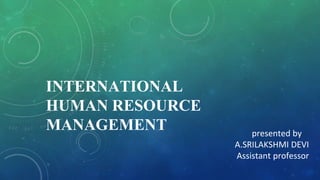
Ihrm cross cultural theories and Recruitment part 2
- 1. INTERNATIONAL HUMAN RESOURCE MANAGEMENT presented by A.SRILAKSHMI DEVI Assistant professor
- 2. CONTENTS ❑ CROSS CULTURAL THEORIES ❑ INTERNATIONAL RECRUITMENT AND SELECTION PROCESS ❑ CULTURE AND VALUES
- 3. CULTURE DEFINITION • Culture is understood as the customs,beliefs,norms and values that guide the behavior of people in a society and that are passed on from one generation to the next. • "Culture encompasses religion, food, what we wear, how we wear it, our language, marriage, music, what we believe is right or wrong, how we sit at the table, how we greet visitors, how we behave with loved ones, and a million other things,“ • Norms. Norms are informal, unwritten rules that govern social behaviors. • Languages. • Festivals. • Rituals & Ceremony. • Holidays. • Pastimes. • Food. • Architecture
- 5. CROSS CULTURE • Cross culture is a concept that recognizes the differences among business people of different nations, backgrounds. and ethnicities, and the importance of bridging them. With globalization, cross culture education has become critically important to businesses.
- 6. THEORIES OF CROSS CULTURE 1 •GLOBE THEORY 2 •HOFSTEDE’S CULTURAL DIMENSIONS 3 •TROMPENAARS FRAMEWORK
- 7. GLOBE(GLOBAL LEADERSHIP & ORGANIZATIONAL BEHAVIOUR EFFECTIVENESS) THEORY ❑Globe Project Team Comprises 170 Researchers Who have Collected data over Seven Years on Cultural Values and Practices and Leadership Attributes from 17,Ooo Managers in 62 Countries ,Covering as Many as 825 Organizations Spread Across the Globe .The Research Team Identified Nine Cultural Dimensions that Distinguish One Society from another and have Important Managerial Implications ❑Globe’s Ranking is Highly helpful to International Managers Who are Seeking to be Successful in Cross Cultural Settings.
- 8. NINE CULTURAL DIMENSIONS ❖ POWER DISTANCE ❖ UNCERTAINTY AVOIDANCE ❖ ASSERTIVENESS ❖ FUTURE ORIENTATIONAL ❖ PERFORMANCE ORIENTATION ❖ HUMAN ORIENTATION ❖ GENDER DIFFERENTIATION ❖ IN-GROUP COLLECTIVISM ❖ COLLECTIVISM/SOCIETAL
- 9. HOFSTEDE'S CULTURAL DIMENSIONS • Psychologist Dr Geert Hofstede published his cultural dimensions model at the end of the 1970s, based on a decade of research. Since then, it's become an internationally recognized standard for understanding cultural differences. • Hofstede studied people who worked for IBM in more than 50 countries. Initially, he identified four dimensions that could distinguish one culture from another. Later, he added fifth and sixth dimensions, in cooperation with Drs Michael H. Bond and Michael Minkov. These are: • Hofstede’s cultural dimensions theory is a framework for cross-cultural communication, developed by Geert Hofstede. • lt describes the effects of a society’s culture on the values of its members, and how these values relate to behavior, using a structure derived from factor analysis.
- 11. ❑ Trompenaars and Hampden-Turner developed the model after spending 10 years researching the preferences and values of people in dozens of cultures around the world. As part of this, they sent questionnaires to more than 46,000 managers in 40 countries. ❑ They found that people from different cultures aren't just randomly different from one another; they differ in very specific, even predictable, ways. This is because each culture has its own way of thinking, its own values and beliefs, and different preferences placed on a variety of different factors. ❑ You can use the model to understand people from different cultural backgrounds better, so that you can prevent misunderstandings and enjoy a better working relationship with them. This is especially useful if you do business with people from around the world, or if you manage a diverse group of people. ❑ Trompenaars and Hampden-Turner concluded that what distinguishes people from one culture compared with another is where these preferences fall in one of the following seven dimensions*: TROMPENAARS FRAMEWORK
- 12. SEVEN DIMENSIONS OF CULTURE
- 13. • Recruitment attracts a large number of qualified applicants who desire to work in a company. • Recruitment means searching for prospective candidates and stimulating them to apply for jobs • Dowling defined “ recruitment is searching for and obtaining potential job candidates in sufficient number and quality so that the organization can select the most appropriate people to fill its job needs”. • Definition: • Globalization has created the need for management talent with knowledge of local markets • Sometimes the most qualified candidates are not found within the limits of one’s own country • Beyond the wider applicant pool hiring outside of your own country is called global recruitment. INTERNATIONAL RECRUITMENT
- 14. TRADITIONAL SOURCES OF RECRUITMENT BY GLOBAL COMPANIES
- 15. MODERN SOURCES OF RECRUITMENT sources Walk-in Consult-in Head-Hunting Body shopping Business alliance Tele - recruitment
- 16. SOURCES OF RECRUITMENT BY COUNTRY NATIONALS PCN • Parent country nationals are employees who are citizens of country where the company headquarters located HCN • HOST COUNTRY NATIONALS are the employees of the company’s subsidiary who are the citizens of the country where the subsidiary is located TCN • THIRD COUNTRY NATIONALS IS AN employee of a company’s subsidiary located in a country,which is not his home country
- 17. SELECTION APPROACHES • Managers are selected from different countries lying within the geographic region(NATIVES) of business. • MOST APPROPRIATE CANDIDATES SELECTED FOR JOBS FROM ANY PART OF THE GLOBE • HCN ARE SELECTED FOR SENIOR MANAGEMENT POSITIONS OF SUBSIDIARIES •PCN’S are selected for key management jobs ETHNOCENTRIC APPROACH POLYCENTRIC APPROACH REGIOCENTRIC APPROACH GEOCENTRIC APPROACH
- 18. SELECTION CRITERIA FOR INTERNATIONAL ASSIGNMENTS/EXPATRIATES SELECTION DECISION TECHNICAL ABILITY CROSS- CULTURE SUITABILITY FAMILY REQUIREM ENTS LANGUAGE CULTURAL REQUIREME NTS MULTINATIO NAL REQUIREMEN TS ADAPTABILITY TO CULTURAL CHANGE LEADERSHIP IN IHRM MOTIVATION FOR FOREIGN ASSIGNMENT
- 19. CULTURES AND VALUES Values guide decision-making and a sense of what’s important and what’s right. Culture is the collection of business practices, processes, and interactions that make up the work environment.
- 20. THANK YOU